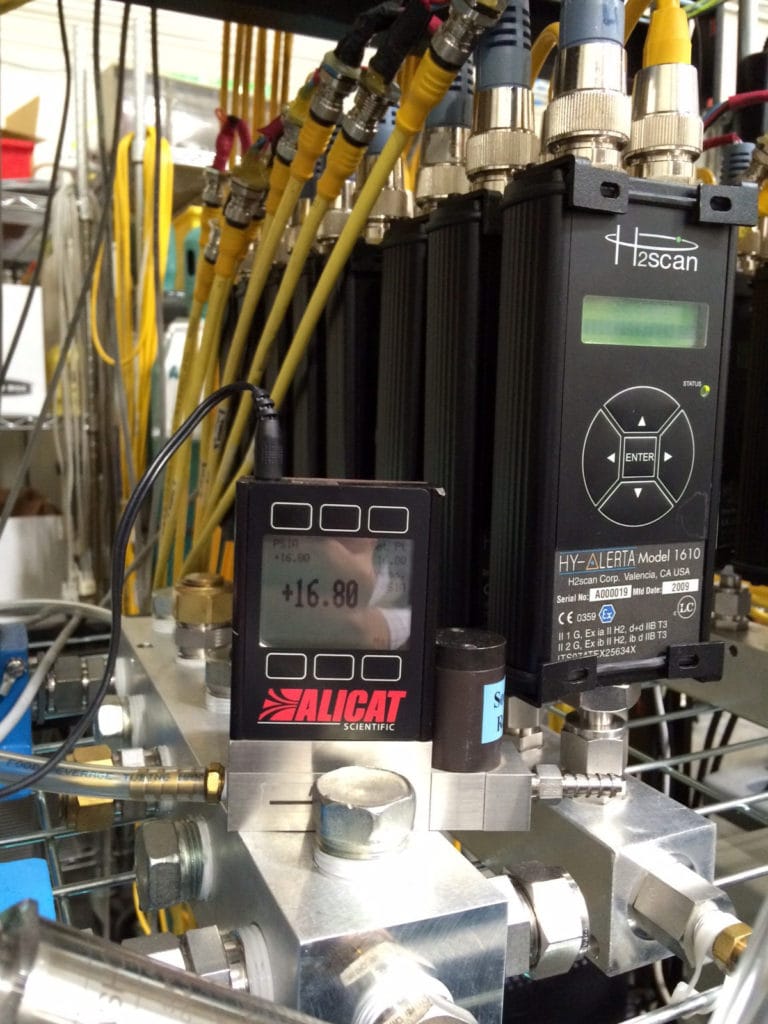Search this article
H2scan improves system stability for accurate hydrogen analysis using absolute pressure control
As a leading manufacturer of hydrogen detectors and analyzers for hydrogen leak detection and process gas monitoring, H2scan has exclusive commercial rights to a solid-state palladium-nickel (Pa-Ni) sensing technology that was first developed by Sandia National Laboratory and the US Department of Energy.

Pressure calibration for H2scan HY-ALERTA hydrogen analyzers
Employing both resistor and capacitor sensing circuits on a single Pa-Ni film, this technology counts hydrogen atoms by measuring the changes in resistance or charge density across the matrix. Only hydrogen atoms respond to the Pa-Ni films, so H2scan instruments can detect the hydrogen content of gases that contain multiple constituents. This ease of use, coupled with real-time readings, makes H2scan’s technology one of the most effective and efficient hydrogen sensing technologies on the market today.
H2scan’s HY-ALERTA product line features both portable and fixed-area hydrogen leak detectors. The company’s HY-OPTIMA product line consists of real-time inline hydrogen monitors for gas process analysis in industrial applications. All H2scan instruments are available in both intrinsically safe and explosion-proof versions. In addition, HY-OPTIMA analyzers may be built either as individual instruments or as complete analyzer systems.
Challenge: Inaccurate hydrogen monitoring
H2scan’s hydrogen analyzers are used in a wide variety of industries, including gas manufacturing, chemical manufacturing, and electrolyzer monitoring among many others. Half of their business comes from the oil and gas industry, where H2scan analyzers monitor hydrogen in gas streams from desulfurization, reforming and hydrocracking. In the last of these, too much hydrogen in the exit stream reveals inefficiencies in the hydrocracking process, and too little hydrogen indicates a reduction of throughput and wasted catalytic material. Inaccuracies in hydrogen monitoring can therefore cost a refinery hundreds of thousands to millions of dollars.
H2scan analyzers typically operate very close to atmospheric pressure. Some time ago, the company received inquiries about some high-purity analyzers that were not reporting accurately in the field, despite passing calibration and inspection before shipping. H2scan sent engineers to customer installations, and they discovered that these gas analyzers were experiencing erratic pressure fluctuations due to changing barometric pressure.
Pressure fluctuations were causing inaccurate readings for these hydrogen analyzers because the number of molecules in a gas volume is proportional to the pressure of the gas. The higher the pressure, the greater number of gas molecules in the same space. At high concentrations of hydrogen, even a small change in barometric pressure could significantly change the number of hydrogen molecules present in the gas stream. Changes in reported hydrogen are directly proportional to pressure changes: a 1% change in pressure will cause a 1% change in reported hydrogen. Stable pressure or a compensated signal is critical, especially at high hydrogen concentrations.
Solution: Absolute pressure control
The solution to this problem was to maintain a constant pressure at the H2scan sensor, and this meant using absolute pressure control. Unlike gauge pressure control, which uses the current barometric pressure as the zero reference, absolute pressure control uses absolute vacuum as the zero reference. Controlling for absolute pressure eliminates atmospheric pressure fluctuations from the equation, resulting in repeatable pressure control and accurate hydrogen gas analysis.
On the recommendation of a colleague, H2scan came to Alicat for standard PC-Series absolute pressure controllers to maintain the pressure at the H2scan sensor head. Configured for back pressure control, the Alicat was installed downstream of the H2scan analyzer to maintain a constant absolute pressure at the analyzer. The high-speed proportional control valve achieves new flow rates in just 50 ms to ensure that the chosen absolute pressure is maintained.
Result: Stable hydrogen analyzer systems
When H2scan engineers added Alicats to their customer’s hydrogen analyzer systems, their analyzers performed as well as they did in the lab, no matter what the barometric pressure was in the field. H2scan now regularly specifies an Alicat back pressure controller to accompany their HY-OPTIMA analyzers when their customer is monitoring gas flows with higher concentrations of hydrogen. Because Alicat pressure controllers are available with NeSSI-compatible flow bodies and CSA Class 1 Division 2 (ATEX Zone 2) certification, H2scan also incorporates these units into HY-OPTIMA complete analyzer systems that are built on NeSSI substrates.
The native RS-232 communications of this “smart” pressure controller provides real-time setpoint control and feedback of the observed absolute pressure. H2scan also uses Alicat’s RS-232 for easy real-time recording of pressures during calibration of non-standard analyzers that operate at higher pressures or require higher accuracy. Alicat supports these easy-to-use electronic pressure controllers with a lifetime warranty and easy access to our expert team of applications engineers.
What’s next for H2scan?
The next generation of H2scan analyzers will automatically compensate hydrogen readings for real-time changes in pressure at the entrance of the analyzer. To accomplish this, the analyzer requires a pressure transducer that can feed back real-time data to the downstream electronic pressure controller. Alicat’s PC-series provides this solution in one device. The back pressure controller is located immediately downstream of the H2scan analyzer, and its native RS-232 communications allows real-time communication with the H2scan analyzer.